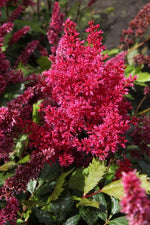
Fanal
770
$7.70
Unit price perAbout Fanal
Astilbe Fanal is a stunning, dark red perennial that is perfect for adding a touch of color to your garden. With its delicate, feathery plumes and lush green leaves, this plant is sure to be a showstopper in any landscape.
- Bright, dark red plumes that bloom in the summertime
- Lush green foliage that adds texture and depth to your garden
- Low maintenance and easy to care for
- Great for adding color to shady areas of your garden
- Grows to a height of 15-18" tall
- Foliage emerges bronze but tends to turn dark green with a reddish tint
How to care for Fanal
- Simply dig a hole in a well-drained, shady area of your garden.
- Add a bit of compost or fertilizer to the soil, and then place the plant in the hole.
- Backfill with soil and water well.
- Keep the soil consistently moist, but not waterlogged.
- To care for Astilbe Fanal, be sure to keep the soil consistently moist and fertilize regularly during the growing season.
- Deadhead spent blooms to encourage new growth and remove any yellow or damaged leaves.
FAQs

